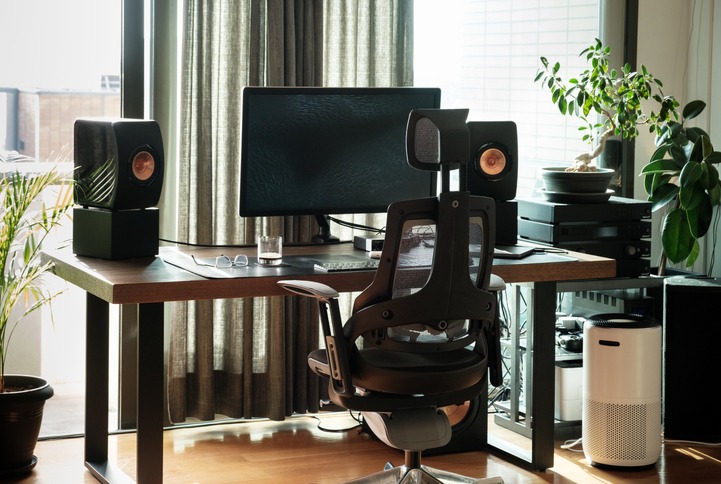
The home office is no longer a temporary workplace, but a permanent one that consumers want to invest in – how can dealers make the transition from B2B into B2C?
Read the full article below or read on page 30 in our February magazine
Since COVID the number of people working from home has spiked dramatically; that’s no big surprise, as business owners realise the benefits of allowing employees more flexibility, and grow increasingly confident that their workforce is, indeed, productive in the home office. In fact, fifty of the biggest UK employers have said they have no plans to return all staff to the office full-time in the near future.
Working from home is proving to be good for the workers too, with an ONS survey revealing that more than three-quarters (78%) of home workers say they have an improved work-life balance; other widely-reported benefits include fewer distractions, improved wellbeing, and the capacity to get work completed more quickly.
While both employees and employers are happy with home working, it looks like it’s here to stay. This presents an opportunity for dealers to sell to a new segment, as Simon Howorth, marketing and design manager at DAMS, explains. “We expect the recent growth in the home office furniture market to continue to increase throughout 2023.
“This provides new opportunities for dealers and office furniture specialists to address the needs of home workers, not only with compact, quality, office furniture designed with ergonomics and well-being in mind, but also with helpful advice on how best to create a healthy and productive home working environment, whatever people’s circumstances or space limitations.”
What are the top products in home office this year?
Those space limitations that Simon alluded to are something home workers are dealing with every day. According to a recent survey by Currys, fewer than a third (28%) of home workers work in a dedicated space. Almost the same number are working in the living room, with 17% working in the bedroom – kitchens, dining rooms, and even a bathroom also featured in the responses.
It’s important that dealers position products for the home office market that don’t necessarily look like industrial, functional, equipment. Nobody wants the corner of their bedroom or lounge to look like a miniature WeWork; rather, they demand stylish yet functional pieces with smart storage solutions to keep the clutter at bay.
Mark Galliano, managing director at Teknik Office, says that his company has enjoyed strong performance from the home office segment and highlights that, given the differing nature of people’s home office setups, products that are both functional and good-looking are key. “We are finding increasingly that a stand-alone workstation, whilst fine for many consumers, isn’t enough for all, so matching associated products like bookcases, filers and sideboards are also important – some of these even lean more towards domestic furniture, which helps them blend into the home.”
In addition to working well in the space available, home office products need to cater for the health and wellbeing of the worker too. Simon says consumers are starting to realise the benefits of investment in ergonomic seating. “When people first started working from home we were selling more of our budget office chairs but gradually, over the last two years, people now appreciate the value and importance of an ergonomic office chair to help prevent bad posture and back issues. They are now seeing it as a long-term investment for their health.”
Jeremy Cooper, marketing manager at Fellowes, agrees that health and wellbeing remain priorities for the home office market, noting that compliance with risk assessment regulations, and other requirements, are key. “Hybrid working solutions that help their employees remain in peak condition, and comply with regulations, have continued to sell well, especially ergonomic desk accessories, smaller shredders to meet GDPR requirements, monitor arms, sit-stand desks and air purifiers.”
It’s quite the challenge to offer products that work in compact spaces, offer healthy, compliant functionality and still look attractive – but there’s another barrier for many dealers to break down, and that’s all about reaching the buyer.
Going from A to B (to C)
One of the biggest challenges for dealers is making the transition from a focus on B2B to selling B2C. Traditionally, these two markets have very much existed in silos, with the B2B dealers having little-to-no visibility with the domestic consumer, and B2C largely existing as high street retailers. Online shopping began to blur these lines some years ago, but the pandemic has seen a rapid acceleration, as Mark explains, “The pandemic hastened this ‘blending’ – consumers went scrambling for products and subsequently broadened the type of place they would purchase from. We noticed some of our B2B dealers really capitalised on this by successfully pivoting to the domestic consumer at just the right time…to huge success in some cases.”
So how can businesses that traditionally focus on the business-to-business market begin to reach the consumer? Dedicating an area of the website to home office products is one of the fastest and easiest ways to begin targeting the consumer market. Jeremy stresses the importance of having an online presence. “It’s really all about content. Get the content right, get found, build reviews and make buying the product easy.”
Dealers shouldn’t be scared to reach out to this demographic – for the most part, these are business-lite customers, and can be dealt with just as easily as the businesses they’ve traded with for years. These are savvy customers, familiar with online shopping, so potential risks of coping with items delivered flat-packed should be considered minimal.
“I don’t think traditional commercial dealers like to sell to Mrs Smith in Scunthorpe, or Mr Jones in Reading, as they feel it’s more trouble than it’s worth,” says Mark. “In reality, these are often business people, and so should be treated as B2B. Most will pay up front and put a claim through their businesses for the products.”
There’s no ‘one-size-fits-all’ approach to breaking into the B2C market; much will come down to what suits the individual dealer. The product range available, resources for marketing and, ultimately, the unique goals of the business will all influence the manner in which dealers choose to reach out to the consumer – but even small steps can yield great results.
So, making the home office part of your 2023 business plan could open doors to new opportunities.


Be the first to comment